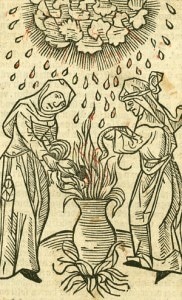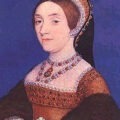
A great article on the UK’s Channel 4 website, entitled “Time Traveller’s Guide to Tudor England” talks about how modern science was in its infancy in the 16th century, as was medicine, and it was natural for people to rely on old-fashioned beliefs and astrology to explain the world and to use potions, charms, amulets and horoscopes to cure ills, for protection and to deal with problems. This article gives an example of a common belief at the time – that toothache was caused by little worms! It sounds silly to us today but perhaps in centuries to come people will look back and laugh at our beliefs.
What I have found interesting in my research into Tudor times and the famous astrologer, mathematician and genius John Dee (a good friend and adviser of Elizabeth I), is that religion, astrology and the use of charms went hand in hand in medieval and Tudor times. As the Channel 4 article says: “Ony the strictest Puritans make a clear distinction between the two [religion and the spirit world]”. It was common for monarchs to consult astrologers to read their nativity charts or to pick auspicious days for events such as coronations or weddings, and for common people to consult “wise men” or “cunning women” about health problems, money problems or marital problems. It all seems very weird looking back on it with our twenty-first century eyes but who are we to judge. Do you consult your horoscope? Do you have a lucky mascot or charm?
White Magic
People who practised white magic were known as “wise men “or “cunning women” and their job was to help people. It was believed that the seventh son of a seventh son would be a white witch and things like slight physical blemishes or deformities were signs of having “the gift”.
The Channel 4 article gives historical examples of white magic being used:-
- Adam Squire, the master of Balliol College (1571-1580), would sell gamblers a “familiar” (a spirit or “fly”) to give them luck at playing dice.
- A cunning woman being sent for by churchwardens in Thatcham, Berkshire, in 1583 to find the thief who stole the communion cloth from the church.
- Thomas Ross’s book “Natural and Artificial Conclusions” (1567) teaching people how to walk on water.
- Prophecies – Elizabeth Barton, the Holy Maid of Kent (or Nun of Kent), prophesying that Henry VIII would meet disaster if he divorced Catherine of Aragon. Barton was allarently visited by the Virgin Mary who gave her this prophecy but the Virgin mary could not save her for being hanged at Tyburn for treason for speaking out against the King.
Charms
Charms could be purchased from wise men or women to ward off evil, to bring good luck, to cure illness, to prevent drunkenness, to find lost property, to get rid of vermin, to get children to sleep, to make someone fall in love with you, to determine the sex of a baby, to put out fires and all other manner of things. They were part of everyday life and not seen as evil or incompatible with religion.
One such charm was the Tudor “angel” coin. This coin was originally issued by Edward IV in the 1460s and featured on their face the Archangel St Michael trampling on a dragon’s head. These coins were seen as powerful charms which could ward off evil spirits and bad luck.
Witches and Witchcraft

The people of the Tudor and Stuart era were not against using charms and believing superstitions but they did fear witches and witchcraft. The Channel 4 article quotes George Gifford, a preacher from Essex, who said:
“If there were no witches, there should be no plagues”
showing that people of the time blamed natural disasters on witches and witchcraft, and they thought that they could prevent such disasters if they got got rid of people thought to be witches. We know that Henry VIII talked about being bewitched by Anne Boleyn, although he probably did not mean it literally, and she was accused of incest, a sin that was linked to witchcraft. Her enemies sought to blacken her name by spreading rumours that she had a sixth finger and a wen on her neck, physical blemishes that could be signs of a witch, and said that she had a deformed baby and cast a spell over the King, causing his obsession with her and his impotence problems. It all sounds ludicrous but in a superstitious age these stories could have been believed.
According to “Witches and Witchcraft in the Medieval World”, concerns over witchcraft grew in the 1540s and Henry VIII went as far as to pass an Act against it, making witchcraft punishable by death. This act was repealed a few years later, but further acts were passed in 1563 and 1604. These acts led to widespread fear and paranoia, witch hunts and many innocent and gifted women being accused of witchcraft and even being hanged. An article on wikipedia on witchcraft tals of three varieties of “witch”, as described by Éva Pócs:-
- The “neighbourhood witch” or “social witch” – This label covers a person who would curse their neighbour after an argument.
- The “sorcerer” or “magical” witch – This label covers healers, seers, sorcerers and even midwives, or anyone thought to use magic to increase their fortune to the detriment of their community.
- The “night” or “supernatural” witch – A person who appears as a demon in visions or dreams.
As you can see from those definitions, it would be very easy for a person to be labelled as a witch because of arguments, tensions in villages and neighbourhoods or their skills at healing or in helping women with childbirth. Many articles on witchcraft in the Tudor and Stuart eras make the point that many of the accused were old women who were poor and lived by themselves. If they fell out with their neighbour, shouted a curse at them in the heat of the moment and then that neighbour suffered some kind of ill fortune then the woman could be accused of causing the ill fortune or accident by her curse, by witchcraft. How sad!
Statistics
More than 90% of those accused of witchcraft between 1450 and 1750 were women and this is probably because they were seen as weaker and therefore more willing to do the Devil’s work. Women were also seen as temptresses and perhaps this harkens back to The Fall of Man, the original sin where Eve sinned and then caused Adam to sin also.
So, how many people were tried and executed for witchcraft in England?
This is hard to answer. Here are some statistics from different sources:-
- The Channel 4 article states in Essex in the 1580s 13% of assize trials were for witchcraft and that out of 64 people accused of witchcraft 53 were found guilty.
- In an article entitled “Women in Tudor and Stuart Times”, Scribd states that 3000 women were officially tried for witchcraft in England between 1563 and 1700 and out of those 400 were hanged.
- “Witches and Witchcraft in the Medieval World” states that there were 785 cases involving 474 witches tried by the Home Circuit (assizes in Essex, Hertfordshire, Kent, Surrey and Sussex) between 1558 and 1709. Only 104 were hanged but 209 were convicted. However, this article points out that figures only take into account formal trials and does not take into account action taken against people thought to be witches by their local communities.
- “Witch Trials in Early Modern Europe” cites statistics from Ronald Hutton, author of “Pagan Religions of the Ancient British Isles” and states that over a 250 year period 228 executions for witchcraft were recorded but it is thought that the actual figure could be anywhere between 300 and 1,000.
Why the Witch Hunts and Paranoia?
In my research on witches and witchcraft it became obvious to me that allegations of witchcraft could be used by the church to control or get rid of people whose beliefs did not fit in with accepted religious beliefs, by communities to get rid of people who were causing arguments and conflicts, or by husbands to rid themselves of annoying wives. I suspect that such allegations were also caused by fear of the unknown, such as the skills of midwives and herbalists, and the need to blame someone and something for accidents and disasters. It is sad to think that many innocent free thinking women and skilled practitioners were labelled as witches and imprisoned or hanged.
The Pendle Witches

The Pendle Witches or Lancashire Witches are the most famous witches in British history. Ten of the thirteen witches were hanged in 1612 at Lancaster gaol after having been found guilty of witchcraft. It was alleged that the thirteen witches had caused the deaths of around seventeen people in the Forest of Pendle area by using witchcraft and that they got the power to kill and harm by selling their souls to “familiars”. The “witches” were accused of causing death to their victims by making effigies known as “pictures of clay” which they then crumbled or burned over a period of time.
The thirteen “witches” were Alizon Device, Elizabeth Device, James Device, Anne Whittle (alias Chattox), Anne Redferne, Alice Nutter, Katherine Hewitt, John Bulcock, Jane Bulcock, Isobel Robey, Elizabeth Southerns (alias Demdike), Jennet Preston and Margaret Pearson. Pearson was found guilty of witchcraft but not murder and so was given a one year prison sentence, Preston was hanged at York because she lived in Yorkshire and Southerns died in prison before the trial. The remaining ten were hanged at Lancaster.
You can find out more about their story at http://www.pendlewitches.co.uk/.

